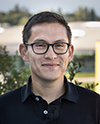Newly appointed tenure-track assistant professor in chemical biology at the EPFL and NCCR Chemical biology, Pablo Rivera-Fuentes moved his lab from ETH Zurich to continue his work on the development of targeted photoactivatable probes, fluorescent sensing of epigenetic modifications and development of photoswitchable dyes for high resolution imaging. We are proud to have him amongst our scholars. Meet him through the answers below and perhaps remember his definition of science “Read, think, do”.
Why are you active in the field of chemical biology?
Because I think that biology is the most fascinating chemical system.
Describe the most intense moment of your career.
Being a postdoc defining the direction of my future lab and applying for academic jobs!
Which is the best idea you ever had?
To become a scientist, and in particular to apply for the Masters program at ETH Zurich when I was an undergrad.
Do you have a role-model or a driving force?
All my mentors have been excellent role models, but to pick a scientist who was not formally my supervisor, that would be Prof. Jack Dunitz. He is a perfect example of how to be a great, influential scientist, and at the same time just a really nice person.
The philosophy along which lines you lead your lab?
Excellent research results can only be achieved in a lab where students are solidly trained. I try to provide the best atmosphere for my students to learn as much as they can. At the same time, research excellence is only sustainable in an environment where people are respectful and tolerant. I try to select for those individuals in my hiring process.
Pick a paper you praise for the elegance of its demonstration.
Science 2006, 313, 1642–1645 and Nat. Methods 2006, 3, 793–796: published almost at the same time, these papers revolutionized microscopy by implementing the simple idea of photoswitching for single-molecule localization.
Can you shed light on the relevance of interdisciplinarity for scientific breakthroughs?
Great things happen when we cross the boundaries of classically-defined sciences to understand nature. This is the case, in part, because techniques and tools from diverse disciplines are brought in, but also because the same problem can be approached from different points of views. Interdisciplinary projects also promote a very healthy mixture of research cultures that is enriching for all parts involved.
Define research with just three words.
Read, think, do.
How do you match the words beauty and science?
The main medium that we use to represent beauty is art. The ability to do art and science is what separates humans from other animals. In a way, both concepts are at the core of what it means to be human.
A piece of advice you’d like to give to the young generation of researchers?
Don’t be blinded by publication metrics, journal brands, social media presence, and prizes. This is not what science should be about.
A book, song, poem, music or painting that you spot out and get inspiration from?
J. S. Bach “Das wohltemperierte Klavier”. It was meant essentially as a book of exercises, but it has some of the most stunning fugues and preludes ever written. It is a great example of how one can produce excellent creative work while teaching the essentials to others.
 Pablo Rivera-Fuentes received his MSc (2009) and PhD (2012) degrees in chemistry from ETH Zurich. Funded by the SNSF, he carried out postdoctoral research at Massachusetts Institute of Technology with Prof. Stephen J. Lippard. He subsequently worked at the University of Oxford with Prof. Harry L. Anderson, FRS (Department of Chemistry) and Prof. Christian Eggeling (Weatherall Institute of Molecular Medicine). He started his independent career as non-tenure-track assistant professor at ETH Zurich in 2015, and became tenure-track assistant professor of chemical biology at EPFL and member of the NCCR Chemical Biology in 2019. His main interests are focused on the development of targeted photoactivatable probes, on fluorescent sensing of epigenetic modifications and on the development of photoswitchable dyes for high resolution imaging.
Pablo Rivera-Fuentes received his MSc (2009) and PhD (2012) degrees in chemistry from ETH Zurich. Funded by the SNSF, he carried out postdoctoral research at Massachusetts Institute of Technology with Prof. Stephen J. Lippard. He subsequently worked at the University of Oxford with Prof. Harry L. Anderson, FRS (Department of Chemistry) and Prof. Christian Eggeling (Weatherall Institute of Molecular Medicine). He started his independent career as non-tenure-track assistant professor at ETH Zurich in 2015, and became tenure-track assistant professor of chemical biology at EPFL and member of the NCCR Chemical Biology in 2019. His main interests are focused on the development of targeted photoactivatable probes, on fluorescent sensing of epigenetic modifications and on the development of photoswitchable dyes for high resolution imaging.

Leave a comment
The editors reserve the right not to publish comments or to abridge them.